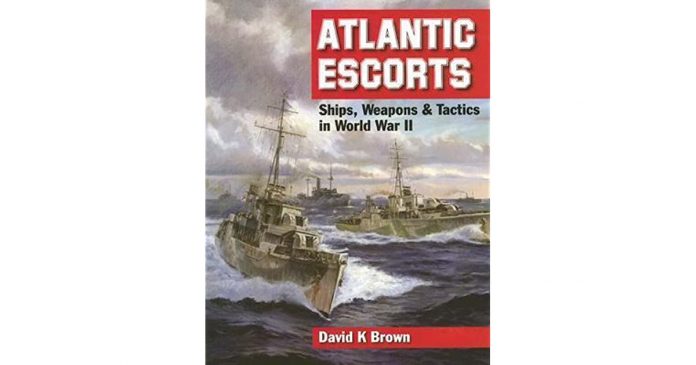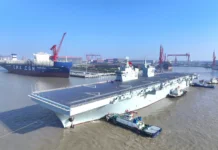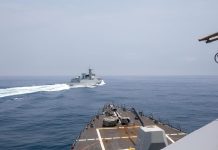
Atlantic Escorts – Ships, Weapons and Tactics in World War II. By David K Brown. Pen and Sword Books Limited, Barnsley, Yorkshire, 2022
Reviewed by John Mortimer
Much has been written over the years about the Battle of the Atlantic covering a range of subjects and approaches. These include aspects of command and control, intelligence, code breaking, technological developments, strategic and tactical considerations and narratives covering operations and trade. This second edition of David Brown’s book “Atlantic Escorts” focuses on the warships that protected the shipping so essential for the survival of Great Britain, and her ability to sustain her population, industry and war effort.
David Brown is eminently suited to write on these matters having spent a long career in warship design and development with the United Kingdom’s Corps of Naval Constructors. He has also authored many books and articles mainly related to warship design and development and naval history. The author combines his skills as a naval constructor with his historical research to provide a revealing examination of the escorts vessels and their contribution to the Battle of the Atlantic. His approach is analytical and scientific in his assessment of ship performance. He is both complimentary and critical where justified, and details the reasons for his views.
The author’s approach deals with escort vessels, their crews, sensors and weapons systems, together with the supporting systems that directed the battle, trained their crews and maintained their hardware. The book starts with a brief discussion of the submarine threat in World War 1 and the pre war situation in terms of threats and budget restraints, and then progresses to discuss the evolution of ships, their equipment, training and technological developments.
Major stages of the battle of the Atlantic are discussed largely in terms of how and why ship designs, weapons and technology evolved to meet the changing nature of the protection of shipping. Initially, the focus was on the provision of escort numbers. At this stage emphasis was on construction of relatively simple designs that could be constructed in a variety of shipyards, both in Great Britain and Canada. This was complemented by conversion of older destroyers and acquisition of aged United States destroyers. The limitations of this approach in terms of poor vessel performance, especially in terms of range and endurance, seakeeping , weapon and ammunition capacity and platform reliability, are clearly articulated. As the battle evolved more emphasis was placed on capability and effectiveness of ships. Hence newer ships tended to be larger, had better endurance, seakeeping, and weapon stowage, and reaped the rewards of improvements in command and control, weapons, sensors and tactical employment .
The author concludes with chapters on some technical aspects of the battle; building the ships to win the battle; how good were the ships; and the development of the fast submarine.
There are some real gems as one goes through the discussion of individual ship classes. For example, the Flower class initially had a planned crew of 29, by the time they entered service in the Western Approaches the crew size had grown to 47 and as additional equipment was provided it grew even further. The ratings quarters for 55 personnel measured 22 feet by 30 feet and had a single urinal two toilets and four washbowls. Sleeping quarters were in two compartments of 20 feet by 14 feet. Food was prepared in a single galley in the aft superstructure and had to be carried across the open welldeck, frequently swept by heavy seas. The author’s comment that “Seasickness reduced the need for eating” is particularly revealing about the rigours of life in the Atlantic on these small escorts.
While the main emphasis of the book is on ships, the author comments on aircraft performance. He is highly critical of the Royal Air Force’s aircraft in the early stages of the campaign. However, in summing up the overall campaign, the author remarks that:
“Later, with a sufficiency of escorts, the coming of asdic Types 144 and 147, together with centimetric radar, reduced the need for numbers, and Hedgehog and Squid made a lethal combination against the older generation of U-boats. However, the future lay with aircraft.”
German development of the fast submarine would have complicated the task of anti-submarine operations, and fortunately none managed to participate in the Atlantic campaign. The widespread development of the fast submarine after the war made those escorts employed in the Battle of the Atlantic largely obsolescent because of their low speed, and limited weapon and sensor performance.
I thoroughly enjoyed this book and highly recommend it to all those with an interest in naval matters, especially naval strategy and planning future force structure. The author is very balanced in his assessment and analysis of the pros and cons of the various ship designs and supports his remarks with first-hand experience and quantifiable data where practical. This book raises important considerations for the current state of anti-submarine warfare and the effectiveness of current and planned solutions to the evolving and challenging problem of increased submarine underwater speed, improved stealth, weapon and sensor developments and growing numbers of submarines and other underwater vehicles in general.
The author’s analysis begs the question whether the retention of traditional approaches to anti submarine warfare are likely in future to provide the success that was achieved in the Second World War. Given Australia’s extensive maritime interests it is not clear how a limited number of very expensive anti submarine escorts and maritime patrol aircraft might provide the core of a viable anti submarine strategy. Have we hoisted in the lessons of the Second World War about growth in ship and crew size, modification requirements to accept additional equipment and sensors, and growth in weapons payloads, and whether such trends are sustainable. Is it reasonable that Australia’s projected specialist ASW ship exceeds the size and displacement of many World War 2 cruisers or should the core of anti submarine surface forces look towards greater numbers of smaller ships. Has our operating doctrine acknowledged the challenges implicit in countering fast moving submarines, nuclear or otherwise, and the increasing complexity that ROVs will bring to understanding what the potential contact is and how effective can our response be. Is our industrial base adequate to provide the training and logistic support, and to implement potential technological developments that can occur at a rapid pace during conflict. Similarly, do we have the doctrinal, analytical and scientific tools to adequately assess our performance and to implement the necessary changes required.



